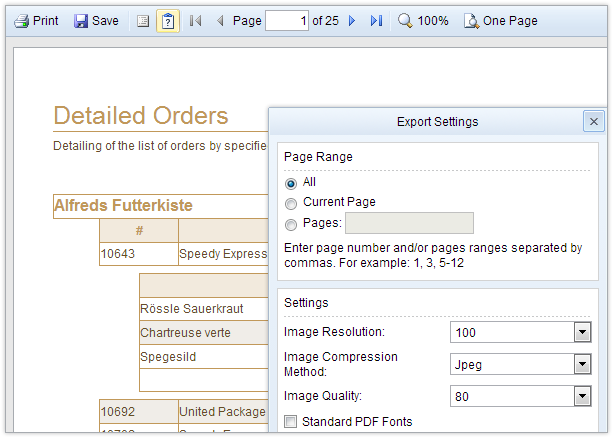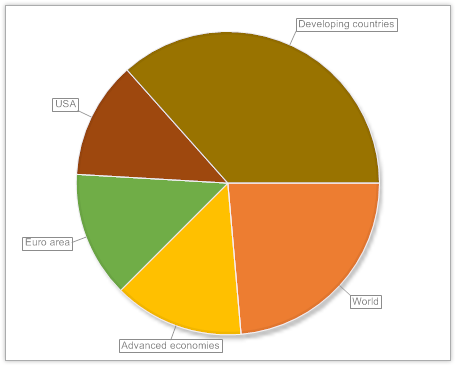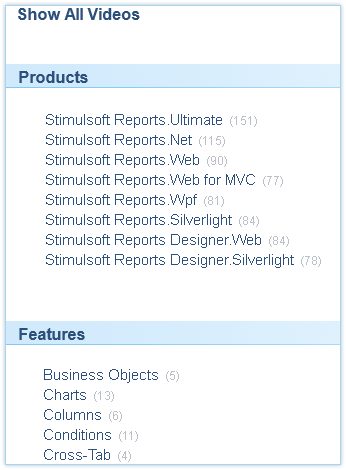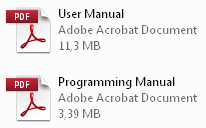We are glad to announce the official release version 2013.1 of Stimulsoft Reports.Fx is now live. The most important changes in this version are enhanced work with data, new functions, localizations, improved videos and revised documentation. There are, however, lots of smaller changes besides the ones mentioned above. Please read below the detailed description of changes.
Web Viewer for HTML 5
The product Reports.Fx for Java now have the AJAX Web Viewer. This component does not use the Flash technology. Only HTML, which allows you to view reports on mobile devices. All requests to the server, such as getting the required report page, zooming, and others occur in the AJAX-mode. So the page is not reloaded every time on the server. That improves the speed and ease of working with the viewer.

New Ultimate Chart Styles
We added 3 new fashionable styles for charts to match the new reports to the theme Office 2013, and more organically perceived by our users.

Improved Memory Consumption
In the software product Reports.Fx for Flex we improved memory consumption options when viewing the report. Now, memory is released after previewing and closing the report viewer, for caching pages, images, reports, and other objects. So now less memory will be used in a Flex application, and rest of it redistributed to other important needs.
Enhanced Work with Data
We have made work to improve and optimize the interaction of the reporting tool with the data in the product Reports.Fx for Java. Added error checking and new data types, improved the interaction of the Flash part to the server.
New Functions
To work more effectively with the data in our reports, we have added new functions.
The Func.EngineHelper.JoinColumnContent function collects all the values of columns in a single row.
The Func.EngineHelper.ToQueryString function collects all the values from the list into a single string with a defined separator to specify the date format.
The ToQueryString function sets the date format of sheets, and is applied directly to the lists.
New Localizations
Now all our products support the UI translation into Norwegian "Bokmål" (nb-NO) and Bahasa Indonesia (in) languages.

API Documentation
Added detailed description of classes for Reports.Fx for Flex (Flex API doc) and Reports.Fx for Java (Java doc). This documentation provides a complete description of all required classes, such as the main class of the report StiReport, component classes, classes for working with the data and report variables. It makes it much easier labor Flex and Java programmers to work on reports from code.
Extended German Localization
You may notice that we have started to focus on the German language, both on our website and in our products. We have translated into German almost all articles and news on the website and blog of Stimulsoft, descriptions of video tutorials. Now news and articles are published simultaneously in English, German, and Russian.
New Videos
Working with videos on our site has become much easier. All the video tutorials are grouped, structured and categorized. They now appear not only as a single long list, but separately by categories, for example, work with the report designer, separately for programmers (all that is related to the source code, etc.). In addition, the videos are structured by specifics, for example, to work with business objects, etc.
In addition, we uploaded our videos on the largest video sharing website, YouTube, which allows users to watch videos on mobile devices.
To simplify the search process for lessons, we have added a detailed description of each of them. With the use of new tools you may find the required video in a simpler manner. Also the description of the video is now available not only in English but in German and Russian.

New Documentations
In the new version of Stimulsoft Reports we decided to revise the documentation and divide it into 2 parts: for normal users and programmers. The user's part of the manual describes the visual part of the reporting tool, report designing approaches. This documentation provides examples for creating reports.
The second part of the documentation, for programmers, describes the basics of using different components in applications. It also reviews the data transferring, questions regarding business objects, etc.
We hope that this division of documentation will help learning our product features.
In addition, our customers will be able to deliver their products with our documentation that is designed for end users.

Web Viewer for HTML 5
The product Reports.Fx for Java now have the AJAX Web Viewer. This component does not use the Flash technology. Only HTML, which allows you to view reports on mobile devices. All requests to the server, such as getting the required report page, zooming, and others occur in the AJAX-mode. So the page is not reloaded every time on the server. That improves the speed and ease of working with the viewer.

New Ultimate Chart Styles
We added 3 new fashionable styles for charts to match the new reports to the theme Office 2013, and more organically perceived by our users.

Improved Memory Consumption
In the software product Reports.Fx for Flex we improved memory consumption options when viewing the report. Now, memory is released after previewing and closing the report viewer, for caching pages, images, reports, and other objects. So now less memory will be used in a Flex application, and rest of it redistributed to other important needs.
Enhanced Work with Data
We have made work to improve and optimize the interaction of the reporting tool with the data in the product Reports.Fx for Java. Added error checking and new data types, improved the interaction of the Flash part to the server.
New Functions
To work more effectively with the data in our reports, we have added new functions.
The Func.EngineHelper.JoinColumnContent function collects all the values of columns in a single row.
The Func.EngineHelper.ToQueryString function collects all the values from the list into a single string with a defined separator to specify the date format.
The ToQueryString function sets the date format of sheets, and is applied directly to the lists.
New Localizations
Now all our products support the UI translation into Norwegian "Bokmål" (nb-NO) and Bahasa Indonesia (in) languages.

API Documentation
Added detailed description of classes for Reports.Fx for Flex (Flex API doc) and Reports.Fx for Java (Java doc). This documentation provides a complete description of all required classes, such as the main class of the report StiReport, component classes, classes for working with the data and report variables. It makes it much easier labor Flex and Java programmers to work on reports from code.
Extended German Localization
You may notice that we have started to focus on the German language, both on our website and in our products. We have translated into German almost all articles and news on the website and blog of Stimulsoft, descriptions of video tutorials. Now news and articles are published simultaneously in English, German, and Russian.
New Videos
Working with videos on our site has become much easier. All the video tutorials are grouped, structured and categorized. They now appear not only as a single long list, but separately by categories, for example, work with the report designer, separately for programmers (all that is related to the source code, etc.). In addition, the videos are structured by specifics, for example, to work with business objects, etc.
In addition, we uploaded our videos on the largest video sharing website, YouTube, which allows users to watch videos on mobile devices.
To simplify the search process for lessons, we have added a detailed description of each of them. With the use of new tools you may find the required video in a simpler manner. Also the description of the video is now available not only in English but in German and Russian.

New Documentations
In the new version of Stimulsoft Reports we decided to revise the documentation and divide it into 2 parts: for normal users and programmers. The user's part of the manual describes the visual part of the reporting tool, report designing approaches. This documentation provides examples for creating reports.
The second part of the documentation, for programmers, describes the basics of using different components in applications. It also reviews the data transferring, questions regarding business objects, etc.
We hope that this division of documentation will help learning our product features.
In addition, our customers will be able to deliver their products with our documentation that is designed for end users.
